At a college football halftime show, Ohio State’s marching band created a spectacle that left every fan in the stadium gasping. In perfect unison, hundreds of musicians and performers formed a living, breathing Michael Jackson, moonwalking across the field with an authenticity that seemed impossible. Every hit — from “Billie Jean” to “Smooth Criminal” — thundered through the stadium, reverberating off the stands. Even fans from rival Iowa found themselves on their feet, clapping and cheering. Phones lit up everywhere, capturing what looked like a miraculous tribute to the King of Pop himself. For a few fleeting minutes, it felt as though Michael Jackson had returned. But as the cheers crescendoed, the impossible spectacle took a darker, more chilling turn.
The lights dimmed, plunging the stadium into a tense hush. The moonwalking figure froze mid-step, as if held in suspended animation. Every musician, every dancer, became still, statuesque. The collective gasp of the crowd mingled with an eerie silence that hung over the field. Then, the massive LED screen at the far end flickered to life, casting a ghostly glow. Words appeared, simple but loaded with intent: “This performance is dedicated to someone watching… you know who you are.”
In a press box above the field, Coach Daniels sat, frozen. His drink slipped from his fingers, shattering on the floor. His face drained of color as the message hit him with the force of a revelation. Twenty years ago, he had buried a secret so dark it had haunted him in private. A young dancer, a Michael Jackson impersonator, had vanished under mysterious circumstances, and the case had gone cold. The performer had carried evidence that could destroy lives. And now, decades later, someone had found a way to deliver justice in front of 100,000 witnesses, on live television, in the middle of a college football game.
The moonwalking figure slowly turned its head, and in a move that froze the world around him, it pointed directly at Coach Daniels. Gasps rippled through the stadium. Cameras zoomed in, capturing the stunned expression on his face. Security personnel rushed into action, but even as they moved toward him, the scene held a surreal, almost cinematic quality. It wasn’t just a halftime show anymore; it was a reckoning, a carefully orchestrated revelation that left the audience reeling.
Spectators whispered among themselves, unsure if they had witnessed a staged spectacle or the unraveling of a real-life mystery. Social media erupted instantly, fans uploading videos, sharing reactions, and speculating about the identity of the mysterious figure and the story behind the cryptic message. Hashtags trended within minutes, drawing people from across the country into the conversation. Was this an artistic statement, a viral stunt, or something much more sinister? People argued, theorized, and tried to piece together the story from the fragmentary clues displayed in those fleeting minutes on the field.
The emotional impact extended beyond mere entertainment. Many in the crowd were forced to confront the thin line between performance and reality. Here was a band, perfectly choreographed and talented beyond belief, delivering a show that felt magical — and then, in a heartbeat, revealing a truth that shook the foundations of a community. It became a conversation starter for every fan, journalist, and casual observer. How far could art go in exposing truth? Could a halftime performance become a platform for justice in the modern age? These questions buzzed through stadiums, living rooms, and social media threads, challenging assumptions about what a “show” could accomplish.
And yet, amid the shock, the spectacle also inspired awe. The precision, creativity, and sheer audacity of the performance reminded fans why college football halftime shows are often more than mere intermissions. They are moments where music, dance, and imagination collide in ways that can surprise even the most seasoned spectators. This particular performance had transcended entertainment, weaving storytelling, suspense, and justice into a single, unforgettable event. Fans discussed the choreography, the timing, and the bravery of the performers, marveling at how seamlessly they transformed the field into a stage for something profoundly unexpected.
People online debated endlessly: who orchestrated this? Was it a collaborative effort between the band and an anonymous whistleblower, or a meticulously planned stunt by a theatrical genius? Theories proliferated, each more intricate than the last. Some suggested the band members were unaware, mere instruments in a larger plan. Others believed every note, every movement, was a deliberate message, crafted to elicit a reaction, to unmask the guilty party in the most public, dramatic way possible. Fans dissected the footage, frame by frame, searching for hidden clues, secret signals, and subtle hints that might explain the layers of meaning embedded in the performance.
Amid the chaos, one thing became clear: the halftime show had transformed into a communal experience, uniting strangers in shared astonishment. People who had come merely to watch a football game found themselves part of a narrative larger than themselves, a story that would be recounted in bars, classrooms, and online forums for weeks to come. The performance reminded everyone that art and spectacle are powerful tools, capable of revealing hidden truths and prompting reflection on personal and societal accountability.
Even as news crews scrambled to report the incident, the story’s implications spread far beyond the stadium. Conversations ignited about morality, responsibility, and the ways in which the past inevitably catches up with us. Fans debated Coach Daniels’ fate, speculated on the performer’s identity, and considered the logistics of orchestrating such an unprecedented display. Forums filled with heartfelt reactions, clever memes, and impassioned discussions about justice, art, and ethics. In a world often numbed by repetition, this performance had cut through the noise, leaving a lasting impression that demanded engagement.
And so, the conversation continues. What would you have done if you were in the stadium? Could you remain a passive observer, or would you feel compelled to question, investigate, and engage? Were the band members heroes, performers, or something in between? Every viewer is invited to interpret the scene in their own way, to weigh the line between justice and theatrics, and to share their own theories and emotional responses. Moments like these remind us of the unique power of live performance: it can surprise, captivate, and, occasionally, hold a mirror up to society itself, challenging us to think, react, and engage.
The story of that unforgettable halftime show isn’t finished. It’s now a dialogue, a shared experience, and a puzzle that will linger in the minds of all who witnessed it. Fans, skeptics, and curious observers alike are drawn into the narrative, invited to debate, discuss, and speculate. Was it art, justice, or something entirely new? Did Michael Jackson truly “return,” or was this always about something more profound? The answers remain unclear, but one thing is undeniable: the performance succeeded in transcending expectation, provoking thought, and compelling action in ways few events ever do.
What’s your take? Do you think this was an elaborate artistic stunt, a cleverly staged confession, or a real-life intervention orchestrated in plain sight? Share your thoughts, theories, and emotional reactions — this is the kind of story that lives and grows through discussion, and your perspective is a part of it. Comment, debate, and engage — because in the wake of this halftime spectacle, everyone has a voice, and every viewpoint helps to unravel the mystery that has captivated a stadium and the world beyond.



